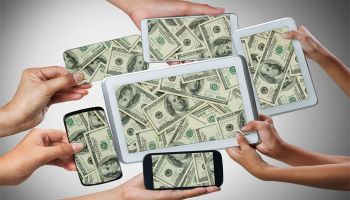Millennials, higher-income consumers drive mobile payments
Security, privacy hinder greater adoption
- |
- Written by Website Staff

Forty percent of North American consumers have used their smartphones to make a payment at a merchant location, according to the 2014 Accenture North American Payments Survey of 4,000 consumers in the U.S. and Canada, up from 16% reported in a similar survey two years ago.
Millennials and high-income consumers—household income of at least $150,000—are the most avid adopters, with 52% of millennials and 55% of high-income consumers having used their phones as a mobile payment device. [See also “American Affluents using more tech”]
“Digital payment technologies are maturing and we have seen more aggressive market entrants that are providing consumers with convenient and secure digital options for making payments,” says Matthew Friend, managing director and head of Accenture Payment Services in North America.
Friend says the firm’s research shows that millennials are most likely of any age group make a mobile payment with a smart phone.
“They are in fact driving the adoption of new payments technologies,” says Friend.
Of those consumers who have never used their mobile phone as a payment device in a merchant location (60%), the two most-cited reasons preventing them from doing so were security concerns (57%) and privacy concerns (45%). [For more about security concerns, see “Making Sense Of It All: Cyber security’s up to you, banks”]
A thought for your bitcoins
Digital currencies usage will increase, the firm predicted, driven by millennials and high-income consumers. The study found that 8% of respondents use digital currencies to complete a payment transaction at least weekly, and 18% expect they will use digital currencies at least weekly by 2020.
Digital currencies were defined as a form of currency or medium of exchange that is electronically created and stored. The primary reasons cited for embracing digital currencies is for protection of personal identity (46%) and lower transaction costs (43%).
Millennials and high-income consumers are expected to drive the use of digital currencies. Today, 13% of millennials and 19% of high-income respondents are using digital currencies to make a payment at least weekly. And 26% of millennials and 32% of high-income consumers expect to do so by 2020.
Lack of information remains the top reason why people today do not use digital currencies, with 38% of consumers not interested in using digital currencies saying they need more information before they will consider it.
“Our survey reveals that customers are increasingly embracing alternative forms of payment,” says Dave Edmondson, senior managing director and head of Accenture’s banking practice in North America.
Edmondson notes that as payments technologies continue to evolve, banks will have to adjust.
“They will need to upgrade their middle- and back-office legacy systems in order to support customer demand for faster, more real-time digital payments,” Edmonson says.
A gradual goodbye to traditional
Traditional payment forms are still dominant, but consumers anticipate using them less and less.
The survey also indicates that by 2020 many traditional payment forms will decrease.
Today, 66% of respondents said they make cash transactions, 59% use debit cards, and 55% use credit cards at least weekly to make a payment.
When asked how they anticipate using these payment instruments in 2020, the respondents indicated they would decrease usage of cash, debit cards, and credit cards as payment instruments at least weekly by 12 percentage points, six percentage points and three percent points, respectively.
“By 2020, we anticipate the first decline in credit card usage in more than five decades and in debit card usage since they were introduced,” says Friend.
While millennials and higher income consumers are paving the way for increased mobile payments and the usage of digital currencies, Friend says, Accenture expects the other age groups to increasingly embrace these payment methods. This will hinge on solutions becoming more consumer friendly and secure, and on more merchants adopting these technologies.”
What mobile users want in payments tools
Among other survey findings, respondents who currently use their smartphones to make payments would do so more frequently, if they had the ability to:
• “Roving checkout.” Scan a product for purchase immediately (71%), eliminating the requirement for check out.
• Avoiding Constanza fat wallet syndrome. Use their phone to track receipts (69%).
• Mobile express lanes. Receive valued customer treatment, such as a separate line to speed up payment (67%).
• “Scan and shop.” Scan a product and learn more about it, such as customer reviews, comparable products or retailer price comparisons (66%).
Respondents who do not currently use their smartphones to make payments would consider doing so, if they were offered:
• Rewards points (54%).
• Discount pricing based on past usage (53%).
• Payment device received and stored all receipts in a secure database and seamless tracked spending habits (52%).
Tagged under Retail Banking, Payments, Channels, Mobile,













